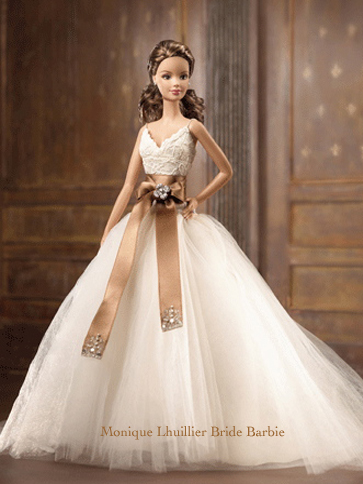Barbie® – A Perpetual Icon
 Many little girls around the world relate their first fashion experience to the Barbie®doll. The very first Barbie®doll was introduced at the American Toy Fair in New York City in 1959. Barbie® was modeled after “Lillie,” a German comic strip, and the very first Barbie®, however, was named after Barbara (Barbie) Handler, whose parents noticed she and her friends had been playing with grown-up dolls as opposed to paper dolls and baby dolls. Even back then, little girls imagined what it would be like to be a grown-up—thus the Barbie®doll.
Many little girls around the world relate their first fashion experience to the Barbie®doll. The very first Barbie®doll was introduced at the American Toy Fair in New York City in 1959. Barbie® was modeled after “Lillie,” a German comic strip, and the very first Barbie®, however, was named after Barbara (Barbie) Handler, whose parents noticed she and her friends had been playing with grown-up dolls as opposed to paper dolls and baby dolls. Even back then, little girls imagined what it would be like to be a grown-up—thus the Barbie®doll.
Almost 50 years have passed, and Barbie has played a big part in setting fashion trends. This quest to be fashionable started with the original founder of Mattel, Ruth Handler, the mother of the original Barbie. Mattel Corporation told her that the doll would never have mass appeal and would be too expensive to manufacture. But after she exhausted her efforts to design a doll, and even getting designers to create her clothes, Mattel finally conceded and made the first Barbie®doll in 1959. That first year, Barbie sold at $3.00 a doll and was a huge success. If you think about inflation and the cost of living, the increase in housing, transportation and travel, the Barbie®doll really hasn’t increased in price that significantly. The average doll only sells for as low as $7.00 and still appeals to the same demographic.
Barbie® has been one of the most collectible toys in history. Part of the appeal is the incredible attention to detail of this doll. Her clothes have always been miniature versions of department store favorites. And when you compare other dolls to Barbie®, you can see the difference in quality. That quality can fetch a price tag ranging from $300 to untold amounts.
Through the years there have been several designers who have been chosen to design a Barbie® garment. The Barbie™ Luxe collection, crafted by a select few designers, includes Anna Sui, who created feminine tops for Barbie®. One of the looks was a pink cotton camisole featuring a neckline decorated with swag-like beadwork. Paper Denim & Cloth created a dark denim bootcut jean with subtle pink detail stitching and light pink hooded zip-up sweatshirt. Accessory designer Anya Hindmarch helped the Barbie® image with makeup tote bags with pink metallic nappa leather trim and handles; Tarina Tarantino created vintage-inspired pendants and necklaces. Other recent contributors to Barbie’s® style are Judith Leiber, Chronic Industries, Jeanie Braden, and Jem Sportswear. This collection is available at Fred Segal Flair and at select Barbie™ Luxe designers’ boutiques. The collection ranges from $16-$625.
Not only has Barbie® influenced fashion, but she has also become the iconic celebrity, appearing in her own movies, books, and CDs. She broke a retail record with her six chart-topping Barbie™ Fairytopia™ films. She has become a powerhouse and family favorite among DVD collections. The genres range from as recent as a high school student to CGI animated looks, and appealing to 6-8 year olds. She was a big hit in Toy Story—I enjoyed that one and I am an adult.
So what is Barbie’s appeal, and most importantly, what gives her that coveted staying power? Is it her body, her chiseled Arian looks? Is it her seemingly untainted party attitude? Is it the multiple careers and seemingly successful demeanor? Is it her ongoing platonic relationship with Ken? Is it her cute little sister or her equally hot best friend? Maybe it’s her Porche or her Arabian horses or her pink mansions or her baby-sitting skills. Whatever it is, I wanted it when I was seven, and I am still striving for it as an adult.
Barbie has crossed the color barriers by creating the black Barbie®, Polynesian Barbie®, blonde, brunette, and red headed Barbie®. She has adopted the looks of popular actresses like Audrey Hepburn, Elizabeth Taylor, and even Oprah Winfrey. She has been the vision of purity as the bride sporting styles from couture designers like Monique Lhuillier™ and Carolina Herrera.
Barbie® doll has been a cherished fashion phenomenon for more than four decades, so it was exciting to be able to dress her in one of my signature gowns. I chose a design for Barbie® that is modern and stylish while maintaining a traditional sense of romantic sentimentality.
—Monique Lhuillier™—
Barbie® has given little girls across the globe the chance to dream. And maybe the majority of those little girls around the world will never be a debutante, or travel the world, or even become a nurse, or the president (all former Barbie® professions), but this icon has never stopped us from hoping. Maybe that’s why Barbie® is still so popular today. She sends a message that our dreams, no matter how big or small, are within our reach.
For more information on the Barbies® mentioned in this article, contact Krisse Mansfield (Mansfield@formulapr.com), Formula 212-219-0321, or Michelle Llorin of Mattel 310-252-4612.
Written by Kaylene Peoples